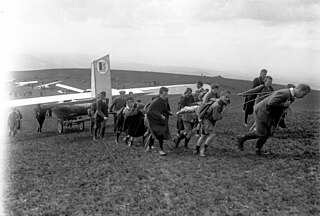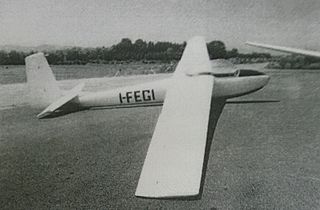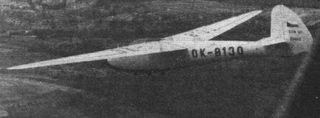Related Research Articles

The Göppingen Gö 4 or Goevier is a German sailplane of the late 1930s used for training pilots. Its most notable features include side-by-side seating and dual controls, making the plane ideal for use as a trainer. It boasted average performance, compared to other gliders of the day, and was advertised as making the process of learning to fly sailplanes easier.
The Latécoère 570 was a twin-engined medium bomber designed to a 1934 specification. It did not fly until 1939, by which time competitor aircraft had gone into service.

The Slingsby Type 51 Dart is a single seat competition glider designed in the early 1960s, initially as a 15 m span Standard Class aircraft but evolved into an Open Class, 17 m sailplane. It was the last Slingsby sailplane to be mostly constructed of wood.

The Akaflieg Darmstadt D-7 Margarete, often shortened to Darmstadt D-7 Margarete, was one of the earliest two seat monoplane gliders, designed and built by German university students in 1923.

The Akaflieg Darmstadt D-9 Konsul, often shortened to Darmstadt D-9 Konsul, was a high performance, single seat, cantilever monoplane sailplane, designed and built by a German University student group in 1923 for hill soaring.
The Akaflieg Darmstadt D-34 sailplanes were a series of experimental single seat sailplanes, designed at the University of Darmstadt in the 1950s and early 1960s to explore the structural and aerodynamic advantages of the then emerging plastics and composite materials.
The experimental Hirth Hi-25 Kria was only the second glider constructed from glass reinforced plastic (GRP). Built in Germany in 1958, it was a single seat, 12 m (39.4 ft) span aircraft. Only one was built; it later flew for several years with Akaflieg Stuttgart.

The Antonov A-9 was a single-seat sailplane designed and built in the USSR in the 1940s, a development of the record setting Red Front 7.
The Kirigamine Mita is a training glider, seating two in tandem, designed in Japan in the early 1960s. A modified version, first flown in 1966, was produced in modest numbers.
The VTC Delfin is a competition single seat Standard class glider designed and built in Yugoslavia in the 1960s. It had some success in national competitions and went into small scale production.
The Bonomi BS.14 Astore was a two-seat training and aerobatic glider, designed and built in Italy in 1935. Only one was constructed.
The Bonomi BS.19 Alca was a single seat, tractor configuration motor glider, designed and built in Italy shortly before World War II. It had an unusual retractable undercarriage used only for take-offs. Only one was built.
The Bonomi BS.22 Alzavola was a training motor glider, intended to acquaint capable glider pilots with the characteristics of powered aircraft. The sole example was designed and built in Italy in the late 1930s.
The Bazzocchi EB.2 was a one off, Italian single seat glider designed and built by a university student in 1936, his second design of the year.

The Rotondi R.2 Tobia was built as a student group project in an Italian technical institute, begun in 1958. The sole example of this single seat, wooden glider first flew in 1962.
The Caproni Vizzola MF and 2 were single-seat gliders built in Italy just before World War II. Intended as training aircraft capable of aerobatics, the two variants differed only in their fuselages. Only one of each was built, but they were both successful in Italian competitions.

The RRG Falke of 1930 was a secondary training glider designed by Alexander Lippisch in Germany and intended to provide better performance than his earlier RRG Prüfling whilst being easier to fly because of its inherent stability. It was sold as plans for both club and commercial production and was built in Germany and abroad.
The Schneider ES-56 Nymph was a short span, Australian glider with a laminar flow wing, built in the 1950s. Only four were built.

The Zlín Šohaj series of club gliders began as a post World War II development of the DFS Olympia Meise. A large number were built in the 1940s and '50s.
The Musger Mg 9 was a tandem two seat glider built in Austria in the mid-1930s. It broke both world and national records.